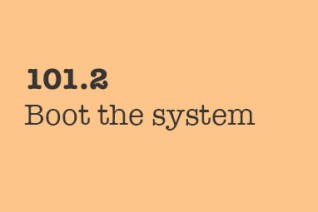
The Owls Blog
Tips & tricks to help you get the most out of your online Learning.
101.2. Boot the system
Iman Mahdavi Doost
101.2. Boot the system
weight: 3
Candidates should be able to guide the system through the booting process.
Key Knowledge Areas
- Provide common commands to the boot loader and options to the kernel at boot time.
- Demonstrate knowledge of the boot sequence from BIOS to boot completion.
- Check boot events in the log files.
Terms
- BIOS
- bootloader
- kernel
- init
- /var/log/messages
- dmesg
BIOS
BIOS is Basic Input Output System and does the first steps of the PC bootup. For example is does a POST (Power On Self Test) and decides which hardware should boot the system.
bootloader
Bootloader can be GRUB (1&2) or LILO which are great for disks less than 2TB.
/etc/lilo.conf
/boot/grub/grub.cfg
/boot/grub/menu.lst
Kernel
Kernel parameters (sometimes called boot parameters) supply the kernel with information about hardware parameters that it might not determine on its own - say single user mod boot (S)
init
When the kernel finishes loading, it usually starts /sbin/init. This program remains running until the system is shut down. It is always assigned process ID 1.
first process, process in charge, a big family tree of commands:
pstree
init is being replaced in many distros (say ubuntu with upstart) but still is in exam and has its own section.
dmesg
Funny fact: During the bootup, only The Kernel is running so it should record and keep its own logs!
dmesg command will show the full data from kernel ring buffer up to now. But
cat /var/log/dmesg
will show only the data during the boot
/var/log/messages
After the init process comes up, syslog daemon will log messages. It has timestamps and will persist during restarts.
- Kernel is still logging its own messages in dmesg
- in some systems it might be called /var/log/syslog
- there are many other logs at /var/log
No Comments Yet...
Leave a reply
Your email address will not be published.
Related Articles

Sidebar
Latest From Our Blog

104.5 Manage file permissions and ownership
by Iman Mahdavi Doost

104.4 Manage disk quotas
by Iman Mahdavi Doost

104.3. Control mounting and unmounting of filesystems
by Iman Mahdavi Doost

104.2 Maintain the integrity of filesystems
by Iman Mahdavi Doost

104.1. Create partitions and filesystems
by Iman Mahdavi Doost

103.8 Perform basic file editing operations using vi
by Iman Mahdavi Doost

103.7 Search text files using regular expressions
by Iman Mahdavi Doost

103.6. Modify process execution priorities
by Iman Mahdavi Doost

03.5. Create, monitor and kill processes
by Iman Mahdavi Doost

103.4. Use streams, pipes and redirects
by Iman Mahdavi Doost

103.3 Perform basic file management
by Iman Mahdavi Doost

103.2. Process text streams using filters
by Iman Mahdavi Doost

103.1. Work on the command line
by Iman Mahdavi Doost

102.5 Use RPM and YUM package management
by Iman Mahdavi Doost

102.4. Use Debian package management
by Iman Mahdavi Doost

102.3. Manage shared libraries
by Iman Mahdavi Doost

102.2 Install a boot manager
by Iman Mahdavi Doost

102.1. Design hard disk layout
by Iman Mahdavi Doost

101.3. Change runlevels and shutdown or reboot system
by Iman Mahdavi Doost

101.2. Boot the system
by Iman Mahdavi Doost